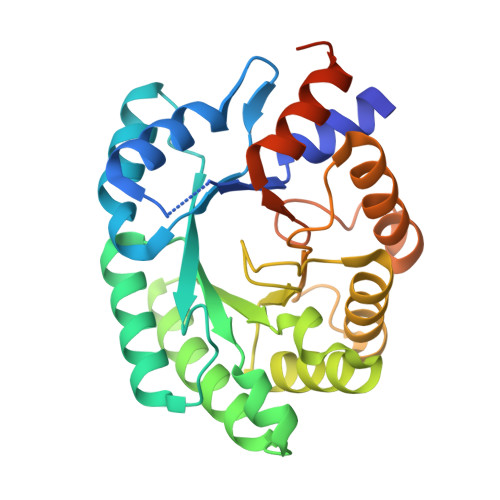Optimization of the in-silico-designed kemp eliminase KE70 by computational design and directed evolution
Khersonsky, O., Rothlisberger, D., Wollacott, A.M., Murphy, P., Dym, O., Albeck, S., Kiss, G., Houk, K.N., Baker, D., Tawfik, D.S.(2011) J Mol Biol 407: 391-412
- PubMed: 21277311
- DOI: https://doi.org/10.1016/j.jmb.2011.01.041
- Primary Citation of Related Structures:
3NPU, 3NPV, 3NPW, 3NPX, 3NQ2, 3NQ8, 3NQV, 3NR0, 3Q2D - PubMed Abstract:
Although de novo computational enzyme design has been shown to be feasible, the field is still in its infancy: the kinetic parameters of designed enzymes are still orders of magnitude lower than those of naturally occurring ones. Nonetheless, designed enzymes can be improved by directed evolution, as recently exemplified for the designed Kemp eliminase KE07. Random mutagenesis and screening resulted in variants with >200-fold higher catalytic efficiency and provided insights about features missing in the designed enzyme. Here we describe the optimization of KE70, another designed Kemp eliminase. Amino acid substitutions predicted to improve catalysis in design calculations involving extensive backbone sampling were individually tested. Those proven beneficial were combinatorially incorporated into the originally designed KE70 along with random mutations, and the resulting libraries were screened for improved eliminase activity. Nine rounds of mutation and selection resulted in >400-fold improvement in the catalytic efficiency of the original KE70 design, reflected in both higher k(cat) values and lower K(m) values, with the best variants exhibiting k(cat)/K(m) values of >5×10(4) s(-)(1) M(-1). The optimized KE70 variants were characterized structurally and biochemically, providing insights into the origins of the improvements in catalysis. Three primary contributions were identified: first, the reshaping of the active-site cavity to achieve tighter substrate binding; second, the fine-tuning of electrostatics around the catalytic His-Asp dyad; and, third, the stabilization of the active-site dyad in a conformation optimal for catalysis.
Organizational Affiliation:
Department of Biological Chemistry, Weizmann Institute of Science, Rehovot 76100, Israel.















